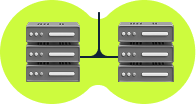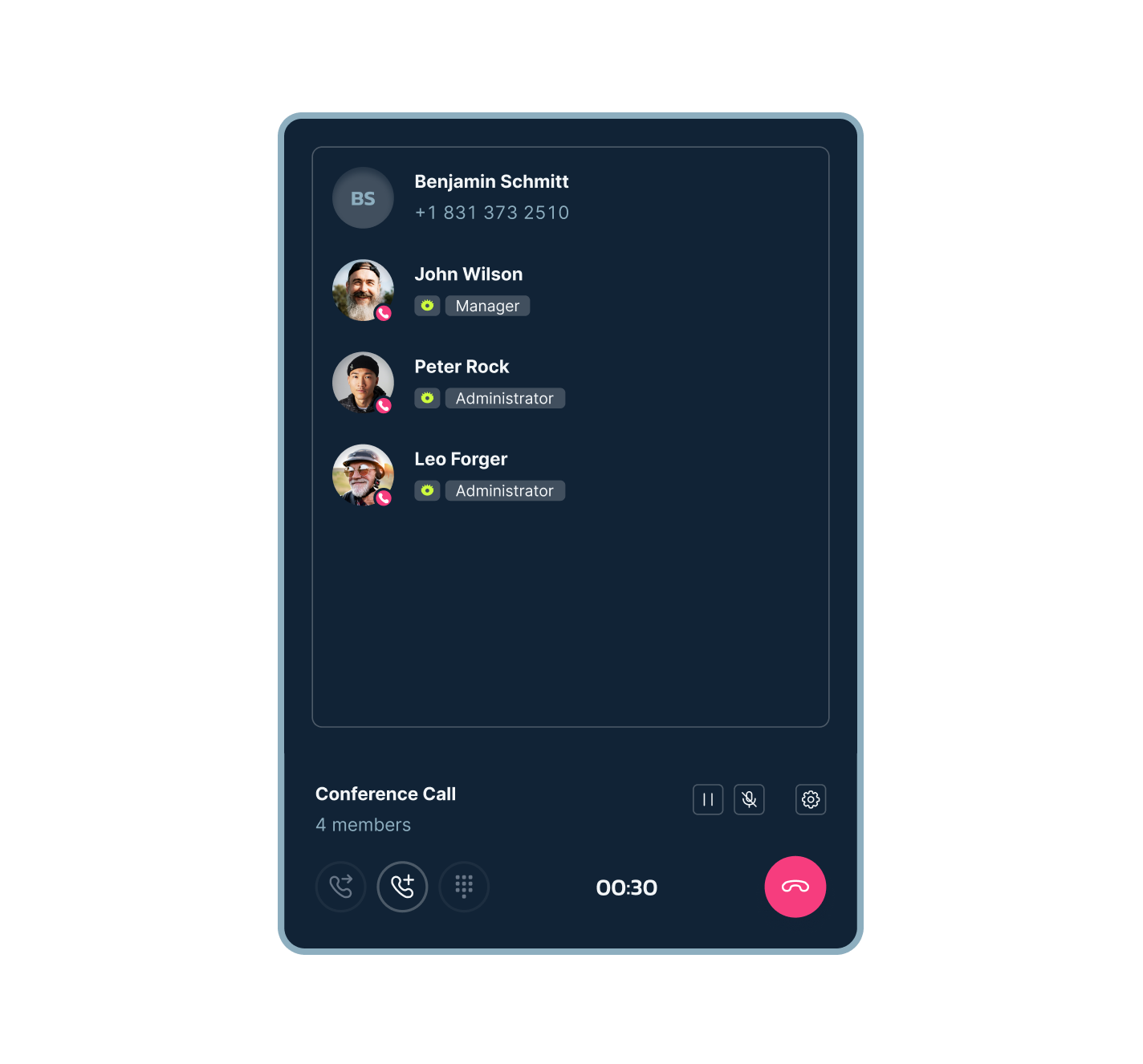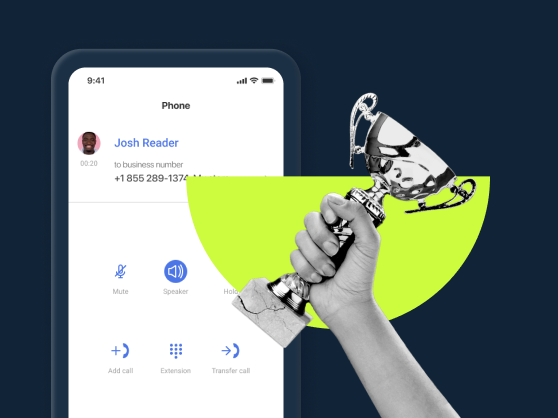What is a conference call?
A conference call facilitates simultaneous communication among multiple participants, unlike a standard two-party phone call. Participants may engage in open discussion or utilize mute functionality as needed.
Businesses frequently utilize conference calls for multi-party discussions and meetings of varying scales. Coupled with speakerphone technology, these calls facilitate simultaneous communication among multiple participants connected through their own lines, enabling efficient mass audio communication.
What does the feature look like?
The conference call feature can be accessed on the web phone. It consists of two buttons: a “Consultative Call” button and a “Conference” button. The former looks like a standard rotary phone receiver standing vertically, with a white plus (+) to the left of it, all of which is within a blue circle. The latter looks like a standard rotary phone receiver sitting horizontally with two lines combining and pointing downwards to the receiver. Access to both buttons can be found on the webphone.
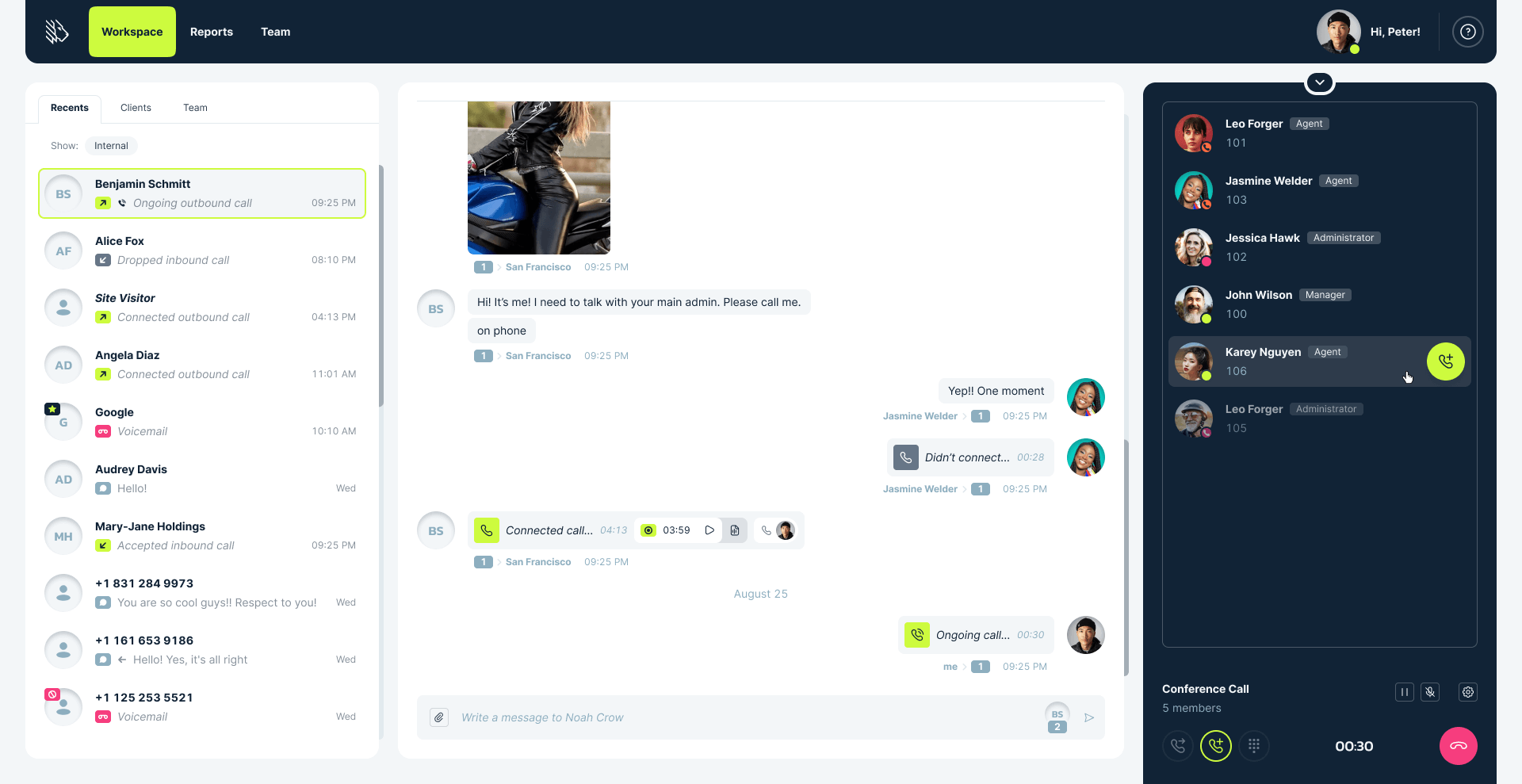
How to make a conference call in MightyCall
The process is incredibly easy, even for the most technologically challenged people. To get started, simply follow these steps:
- Start in the MightyCall web panel. MightyCall is VoIP, which means you can do conference calls online.
- Open the webphone by clicking the phone icon in the top right of the screen.
- Start the conference by dialing the first number you would want to start the call with. Then, start the call.
- Then, click the Consultative icon, mentioned previously. Dial-in numbers you’d like to call, and then call. Once the call connects, hit the Conference button to begin the teleconference.
How does conference call work?
There are a few different types to be aware of. Some people prefer one way; others prefer another. See which is best for you!
- The host adds participants to the call: they dial-in numbers, add every meeting participant, the whole thing. This is the classic conference calling.
- Conference bridge: think of this as a virtual area which you can be invited to. With a code, ID, or conference bridge number, people are allowed to enter the room and join the chat.
Types of conference calls
It can be difficult to wrap your head around the different types of conference lines. No worries! Here’s a handy guide for the basics of it:
| Web | Audio | Visual | |
|---|---|---|---|
| How it functions | Connects users over the internet via IP phones | Works over the internet or with standard desk phone or landline setups. Users “dial in” from their phones | Webcams (or other types of cameras) are employed, along with microphones, to send live imagery over the internet in order to connect users via video calling |
| Pros | Straightforward to use and accessible anywhere with an internet connection. Takes advantage of internet-based features. | Reliable and relatively inexpensive. Easy to use, even for those who lack technical proficiency. | Callers can see the people they are talking to for a more personal conversation. Involves the use of smartphones or webcams |
| Cons | Reliant on strong Wi-Fi or signal | Cannot have videos or more advanced features/settings | Requires greater bandwidth and data packet use and can be choppy |
Web conference calls vs phone conference calls
The difference between a web conference and a phone conference can be difficult to understand at times for those who are not technologically aware. Here are the minutiae of the differences between them:
Web conference calls
These are done over the internet, oftentimes with a VoIP system. These VoIP conference calls can be done the traditional way, with someone adding participants, or through newer means, like using a conference bridge.
The benefits of using a VoIP-based call provider are that you can combine your calls with other extremely useful web-only features, like call recording and auto attendant, and can sometimes be seamlessly launched instead of having to jump through hoops to get it started.
Phone conference calls
These conference meetings are the more traditional ways of running a call, as these meetings do not require any software and can be used with simple landlines or traditional phones (though smartphones can be used as well). The conference call organizer simply dials people in or has them dial in via traditional phone lines.
Conference call features (and more) in MightyCall
- Mute your microphone: This feature mutes your microphone, preventing others from hearing your audio while allowing you to continue hearing participants.
- On hold: This feature allows you to briefly hold a conversation without disconnecting. You can resume the call seamlessly when ready.
- Make a direct transfer: This feature “sends” the caller from your “telephone number” to another without first speaking with the person being transferred to.
- Make a consultative transfer: Alternatively, this option initiates a consultation with the intended recipient before merging the calls and disconnecting, allowing the other two parties to continue their conversation
Conference call on Android and iOS
Access all MightyCall features from anywhere globally with our free mobile app, available now for iOS and Android.


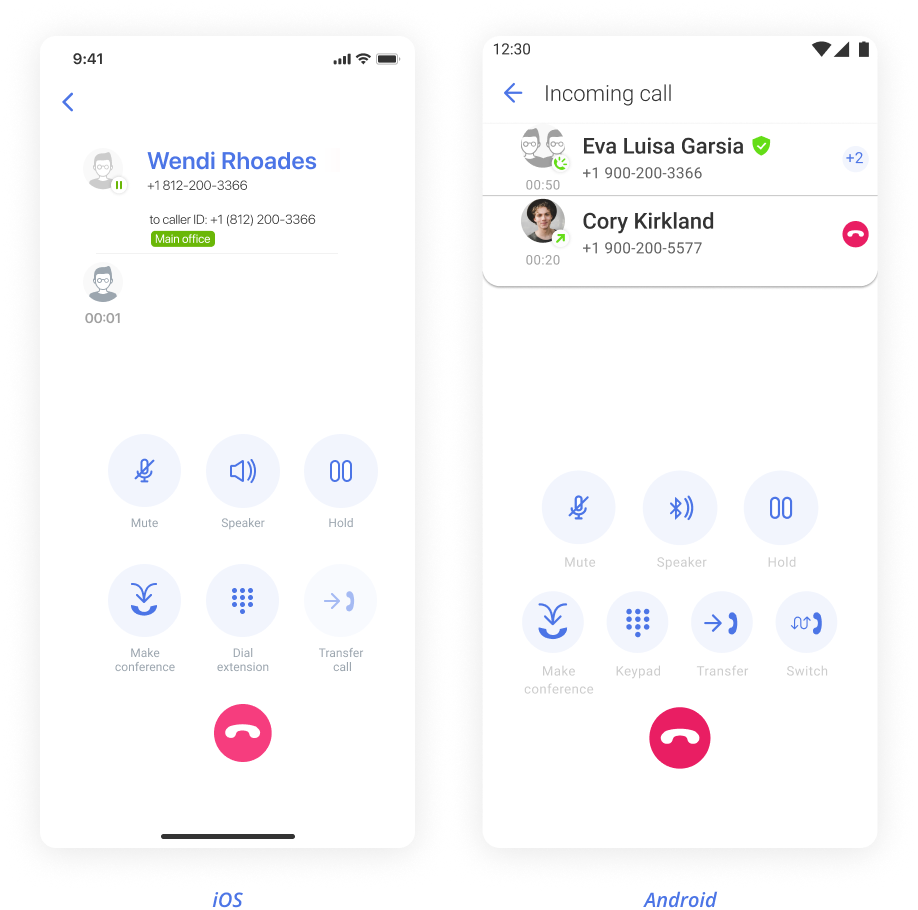
Why use conference calls?
Individuals possessing a telephone number but lacking experience with conference call services may be unaware of the associated benefits. Here are some reasons why you might want to consider using this feature:
You work in a team
The primary advantage of conferencing is its facilitation of real-time communication within teams working on complex projects. Direct discussion, as opposed to email exchanges, significantly improves efficiency and expedites problem resolution.
You are not empowered with the right communication tools
Regarding email communication, reliable delivery, and read confirmation cannot be guaranteed. Once an email is sent, the sender loses direct control; without specialized tracking software, read confirmation is impossible.
Your team is spread out
Consider a contemporary organization with geographically dispersed offices and personnel across a city, state, or even nationwide. While centralized office space may be feasible for a single-city workforce, it presents significant logistical challenges for state-wide or national teams.
Your team is working with a major client
For individual communication, standard calling practices are sufficient. However, when multiple team members interact with a client, simultaneous participation in calls ensures consistent information sharing and prevents critical team members from being excluded, which could lead to significant oversights.
Use case
For example, you are working in the financial department and you received a call from a customer who wants to sign up for a customized plan and find out the price immediately. Hence you would want to add a sales specialist to your call so you, the customer, and the sales specialist can discuss it altogether.
Best conference calls practices
Use a good microphone
Nothing can be more frustrating than participating in a long call with a person whom you cannot understand – especially when it’s a call with a lot of people in it. Prior to such calls, ensure you have a high-quality microphone; affordable, readily available options. If it’s a professional setting, poor microphone quality is no excuse. It will come across to clients as unprofessional and colleagues as grating.
Do it in a quiet place
If you can, make sure that the noise level is very low when talking during phone conference calls. Excessive noise and auditory disrupt the flow of conversation and hinder productive exchanges.
Use headphones
But if you absolutely cannot find a quiet area, then use headphones during phone conference calls, whether you’re using an IP phone or a standard phone. Utilizing headphones will mitigate ambient noise and enhance call clarity, thereby eliminating the need for repeated requests to repeat statements. This will optimize workflow and prevent the necessity of scheduling subsequent calls.
Test ahead of time
Prior to joining a conference call, please verify that your equipment is functioning correctly. Many conference services offer pre-call testing; therefore, ensuring operational readiness is entirely feasible.
Make sure callers have the proper login information (if necessary)
Some modern call services require either a link or a password to enter. If you are organizing a conference call, make sure that everyone is made aware of what they need – nothing will be more frustrating for the people you are supposed to be speaking with if they’ve carved out time for a call but you have not given them a way to join in!
Helpful terms to know about conference calls
VoIP – It stands for voice over internet protocol, and is a telephony system which allows users to make calls over the internet. It has become incredibly popular and is an extremely useful tool when making calls of various sizes and lengths.
ID/Access Code – These are usually randomly generated digits, though sometimes the creator of the call can make their own codes (usually short phrases or likewise random digits). You input this dial-in number to gain access to the teleconference, and are given it ahead of time by the organizer via text or email (or, if you work in an office, in person).
Boot – This is internet slang for kicking someone out. You may have heard “Give someone the boot,” and it’s the same thing here. Getting booted from a server or a call means you have been kicked out. This is different from simply being dropped; being booted means someone purposefully removed you from the call.
Lecture Mode – This is a setting found on some software. It allows the user to start the call in a special mode in which only they can talk (like a lecture), and where the attendees can raise their hands or otherwise notify the “lecturer” that they would like to speak. They need permission to do so.
Ready to start using conference calls meetings?
Conference call meetings is a way of organizing your calls to maximize potential and inclusivity. Lots of VoIP companies offer this feature – but you shouldn’t only expect conferencing. You should look for world-class security, high uptime, reliability, a strong customer service department, and dozens of other key features. Put this all together, and what does it mean? It means you’re looking for MightyCall, one of the leaders in VoIP telephony services.
